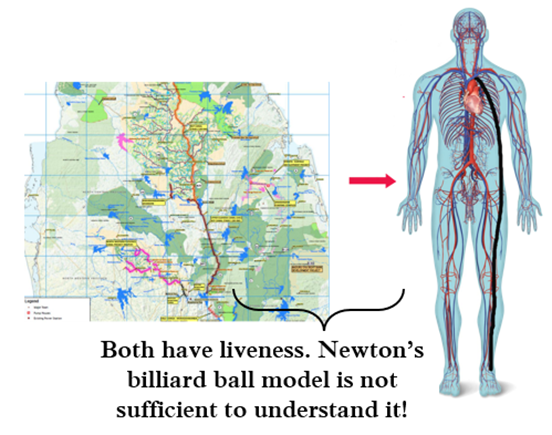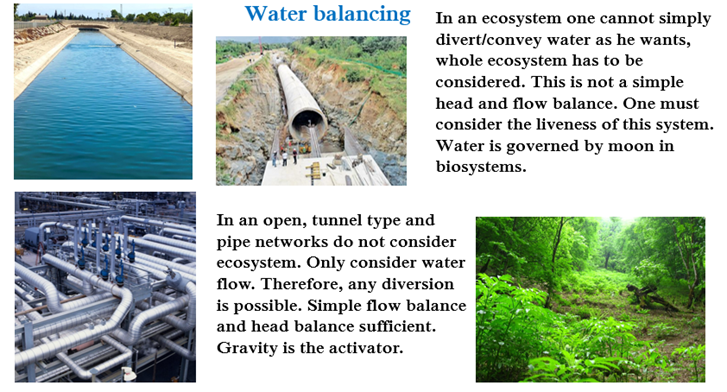Water – head, flow balances in modern and ecology based systems
By Eng. Kapila Peris
In modern water works comprising of conduits, canals, pipes flow weirs, pumps, turbines, sluices etc. the concepts of flow and head balances comes under the purview of Newton's mechanics (within the billiard ball model) are used for all modelling and calculations. Apart from the basic head flow balances, various head losses are estimated by various kind of empirical equations. Also the estimation of surface runoffs, hydro graphs are based on similar manner.
All this water head works are macroscopic and the above said models works quite satisfactory in those realms. But these models cannot be expected to work for biological systems. Because in the first case the basic relations derived (rather formulated) only at macroscopic level and most importantly for inanimate physical mechanical systems inside laboratory. Therefore is it scientific to use them to model biological systems which seriously show strange phenomena which certainly goes beyond Newtonian paradigm.
Therefore can we write water balance and head balance equations for an ecosystem comprising of various plants, micro and macro fauna and a complex topography which is covered by again a complex soil strata with millions of living beings.
Although people try to model these systems, it should be clearly understood that these models will be severely “cut and chopped” type ones. The water within a biological system does not obey hydraulics under Newtonian paradigm. This water is influenced by “forming forces” within those systems. Even the validity of H2O model for water in such circumstances is a serious issue. Ecosystem is a highly biological entity. Therefore the most unscientific endeavor is trying to model it with physical mechanical modelling tools. Without understanding this erroneous approach and asking to prove that biological systems does not behave according to Newtonian paradigm is a much more unscientific.
First of all one must understand our limits, we get all the information through 5 sense faculties all our models are based on these. Then how our ancestors did develop such marvelous sustainable water related systems and why such knowledge is lacking in our modern experts who are masters of various kinds of mechanics, Biology, zoology, biochemistry, forest sciences etc.
We have to find out an answer for this question, before proceeding with our ancient systems. Before trying to develop highly conjected models about our ancient systems based only on historical evidences, artifacts and various literature, one has to solve this problem. Otherwise it will be comparable to a situation where a blind man trying to understand the works of people with clear vision. For an example there are clear evidence to show that moon has a direct relation with water in biological systems which cannot be understood by our physical knowledge.
According to our physical knowledge based on five faculties the following activities can be understood with in an ecosystem, evaporation and transpiration are balanced so as to maintain a suitable condition for the ecosystem. Transpiration is responsible for convective rains for reuse of water in the system, fauna in soil makes proper conditions in soil for proper water behavior and there are many more strange communications within the system and many other phenomena which are to be understood yet. Especially with developed faculties. This is not a problem of complexity with same phenomena (in Newtonian paradigm), but it is a problem of different phenomena as well. Therefore weather the number based mathematical models are valid for such a system is even a problematic issue.
In traditional water (balancing) models for ecosystems the whole is divided into various small parts and for each part the related characteristic equations are formulated (empirically or semi empirically), then various combinations of water (amount) Momentum and energy balance equations are written for the appropriate parts of the system and they are amalgamated. With such models it is expected to predict the behavior of the system with variations of outside influencing parameters such as rainfall sunshine, wind, human activities, plant growth etc. The major assumption in this approach which we have to consider seriously is the validity of the characteristic relations used for each individual part derived under isolated conditions in the context of actual wholistic conditions where complex inter-connected activities are taking place.
Is it possible to consider all the effects and write equations? In such case how many million combinations will be there to do experiments according to modern scientific method. All this does not exclude modelling as such, but show the importance of knowing the limits of the same and seriously suggests a way forward with ecosystems by clear observations. Working within the ecosystem rather than getting away from it and trying to model it with speculated (mind made) models.
It will be an interesting endeavor to find out details about the emergence of the concept of such models. Did our ancestors had the concept of “modelling” in any particular manner?
According to Dr. Wasantha Lal who is an specialist for such water works and hydraulics, “in USA study of water balance alone stopped in 1980s, now everything comes under watershed modelling where floods water supply and the environment always studied together.” This seem to be a somewhat deviation from macroscopic level analysis of microscopic systems and marching towards a Wholistic approach for such systems where microscopic activities are clustered together. But we are not clear about whether at least they consider about moon’s effect on such microscopic Biosystems.
The approach of USA seems to be comparable to studying the water supply to a human and water rejected by him as a whole without trying to analyse the behavior of water within the body. Once the proper amount (this is also given by the body itself) of water is supplied, all the controlling is done within the body for the welfare of the same, and excess is rejected.
Up to now what has been done is like connecting various tubes, path ways and supplying water to the body in different openings rather than from mouth and manipulating the water - body system according to our physical mechanical understanding. Now at least they have understood the mistake up to a certain extent. Now they are studying the body as a unit.
But in our case when we go through our works and experiences, we have directly and indirectly with people such as irshis and even today with the activities of our vedha mahaththayas etc., it is clear that they have a significant knowledge even about the activities of water Biosystems at microscopic level itself. Which westerners seems to not possess. With simply only with a wholistic approach in USA, it is highly unthinkable to treat a biological system, may be a human, animal body or an ecosystem and to get satisfactory results. Therefore now it is high time to penetrate to our knowledge systems with proper channels going beyond five sense organs and use them for future work.
Actually we need a paradigm shift to understand ecological systems which consists of real biology, not the physics and chemistry which are thought as biology in western science.


 Eng. Kapila Peiris graduated with a BSc degree in the specialization of mechanical engineering from the University of Moratuwa. He holds a degree of Master of philosophy in agriculture engineering and Master of Arts in Buddhist studies. He served as a visiting Lecturer in universities of Moratuwa. Ruhuna, Open university of Sri Lanka and Vocational University. He, furthermore, serves as a member in the indigenous knowledge committee of National Science Foundation of Sri Lanka. and as a member of Museum committee at I.E.S.L. He has published more than 30 research publications in various journals on Engineering. In addition, He has written 80 articles for Vidusara science newspaper on science and engineering concepts. Eng. Kapila Peiris is a Research Fellow who serves NERDC for more than 20 years. He is an expert in Advance Thermodynamics, Engineering mechanics, Engineering Mathematics and Eng. Applied thermodynamics and refrigeration.
Eng. Kapila Peiris graduated with a BSc degree in the specialization of mechanical engineering from the University of Moratuwa. He holds a degree of Master of philosophy in agriculture engineering and Master of Arts in Buddhist studies. He served as a visiting Lecturer in universities of Moratuwa. Ruhuna, Open university of Sri Lanka and Vocational University. He, furthermore, serves as a member in the indigenous knowledge committee of National Science Foundation of Sri Lanka. and as a member of Museum committee at I.E.S.L. He has published more than 30 research publications in various journals on Engineering. In addition, He has written 80 articles for Vidusara science newspaper on science and engineering concepts. Eng. Kapila Peiris is a Research Fellow who serves NERDC for more than 20 years. He is an expert in Advance Thermodynamics, Engineering mechanics, Engineering Mathematics and Eng. Applied thermodynamics and refrigeration.





